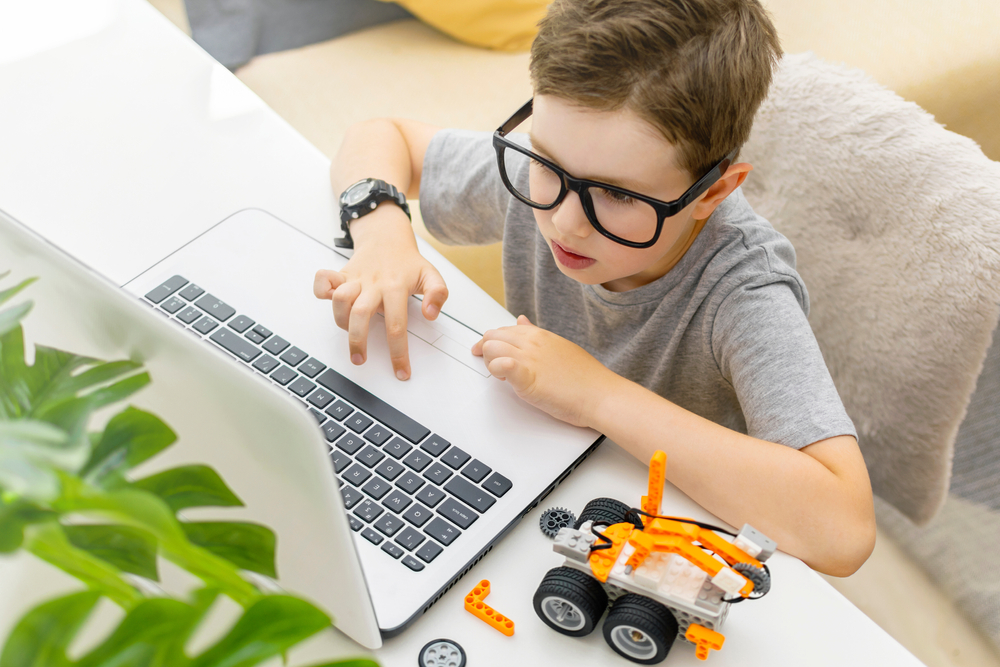Can Kids Vibe Code?
- August 4, 2025
- By Ryan Harris
Imagine coding that feels more like jamming on your favorite song than typing line after line of instructions. That’s vibe coding: an approach where developers craft software by ‘feeling’ their way through creative patterns assisted by AI agents. This revolutionary method is shaking up development teams worldwide, and surprisingly, it’s something kids can start practicing right now. After all, coding competitions are big for kids, so why shouldn’t they be getting into the newest method for developing apps, games, and programs?

What is Vibe Coding?
Vibe coding represents a dramatic shift from traditional programming approaches. Rather than memorizing rigid syntax rules and typing endless lines of code, vibe coding emphasizes tapping into intuition and ‘feeling your way through code.’ This approach was popularized by OpenAI co-founder Andrej Karpathy, who described it as ‘giving into the vibes, embrace exponentials, and forget that code even exists.’
The core philosophy centers on ‘feel first, polish later,’ encouraging pattern recognition through practice instead of rote memorization. It’s comparable to learning a language by speaking and making mistakes rather than just memorizing grammar rules. Unlike traditional coding, vibe coding is intended to be fluid and expressive, like freestyle sketching, compared to following step-by-step drawing tutorials.
Applications and Examples of Vibe Coding
Vibe coding relies heavily on AI-powered tools that use large language models to produce functional code from simple text prompts. Key platforms include Replit, Cursor, GitHub Copilot, Claude Code, and Windsurf, which allow users to describe their desired outcome in plain language while the AI interprets and generates working code.
The real-world applications are remarkable. Individuals without traditional coding backgrounds are building functional applications across diverse categories. In health and wellness, people have created carb counters for diabetes management, personalized workout apps, and meal planning tools that analyze fridge photos. Parents are developing story creation apps for children, bedtime storytelling platforms, and chore management systems. Professional productivity tools include meeting preparation automation, time tracking applications, and inbox management systems.
Recent studies show vibe coding significantly boosts productivity, with reports indicating up to 55% faster completion times and a 40% reduction in debugging effort. This efficiency gain frees experienced developers from repetitive tasks while enabling non-technical individuals to build sophisticated applications, acting as what many describe as the ‘biggest unlock’ for aspiring entrepreneurs.
Can Children Vibe Code? Skills Beyond Intuition
Vibe Coding as Beginner-Friendly
Vibe coding proves surprisingly accessible to beginners, particularly children with experience in music, art, or language learning. The approach emphasizes understanding patterns, recognizing flows, and developing intuition about what comes next: skills that young minds naturally possess. Recent educational initiatives show that kids can be introduced to vibe coding concepts alongside fundamental programming concepts from day one.
For children, vibe coding transcends mastering complex programming languages like Python or JavaScript. Instead, it fosters creativity, problem-solving abilities, and storytelling skills. This approach creates an engaging, imaginative learning environment that naturally sparks curiosity through storytelling, animations, music, and visuals that immerse children in their projects.
Success stories are emerging from schools worldwide. Children are becoming so engaged they skip lunch breaks to continue coding, building 2D games, creating sleek user interfaces, and developing 3D interactive worlds. These experiences boost creativity, develop logical thinking, promote collaboration, build confidence, and prepare young learners for an increasingly digital future.
Challenges and Potential Pitfalls for Beginners
Despite its accessibility, vibe coding presents certain challenges for young learners. Not all children thrive in free-flow environments. Some require structured rules before they can confidently break them, and this learning preference is perfectly acceptable.
A critical concern involves misinterpreting intuition as mere guesswork. While feeling your way through code is central to vibe coding, the approach still requires logical thinking. It’s more like cooking without a recipe, based on understanding ingredients and techniques, rather than randomly combining elements hoping for success.
The shallow understanding problem represents a significant concern, as AI coding assistants may lead to surface-level comprehension of core programming skills. Beginners might struggle to explain or reason about AI-generated code, making debugging, maintenance, or future improvements challenging. Over-reliance on AI tools can potentially hinder the development of essential problem-solving and critical thinking abilities.
Additionally, AI-generated code often contains mistakes, with studies showing significant error rates, and may introduce security vulnerabilities. The necessity of managing multiple tools, each with unique setups and interfaces, can overwhelm beginners and slow learning progress.
Essential Skills Alongside Vibe Coding
Despite AI advancements, foundational coding knowledge remains crucial. Core programming concepts help children understand how code functions, build confidence, and ensure long-term code maintainability. Skills in HTML, CSS, and JavaScript provide essential foundations for both problem-solving and creative expression.
Prompt engineering (knowing how to effectively instruct AI tools to generate high-quality code) emerges as a critical modern skill. Vibe coding principles mean that prompting is the new programming, requiring clear, context-sensitive instructions to achieve desired outcomes.
Human oversight of AI-generated code remains vital for ensuring quality, security, and maintainability. This includes reviewing for errors, potential biases, and compliance with ethical standards. Even with AI assistance, logical thinking and debugging skills prove invaluable. Young coders can develop an intuitive ‘sense’ when something seems wrong with code, a skill experienced developers describe as gold.
Finally, responsible AI use becomes paramount, emphasizing data privacy, security, and ethical reasoning to safeguard against bias and vulnerabilities in AI-generated solutions.
Best Practices and Activities for Kids
Educational programs can teach vibe methodology by pairing students to build projects in real-time, focusing more on intuition than theory. Classroom exercises can include live coding sessions, creative challenges, and hackathons to help develop rhythm and flow. Project-based activities, particularly game development and animation creation, prove especially effective for young learners.
Visual code editors and platforms like Replit, CodePen, and Glitch encourage hands-on exploration, allowing users to break, fix, and learn in real-time. Advanced coding environments with extensions, themes, and live previews can elevate the vibe by creating spaces where code feels alive and responsive. No-code platforms such as Bubble, Webflow, and others serve as excellent entry points for absolute beginners.
Mentorship and peer learning prove invaluable in vibe coding education. When beginners code alongside mentors, they absorb subtle patterns and practices through osmosis. Learning with peers, sharing mistakes, and celebrating breakthroughs wil make sure they’re on the right path.
Vibe coding can even become an engaging parent-child activity, fostering collaborative learning experiences that strengthen family bonds while building technical skills.
Developing these vibe coding skills can be a major part of developing AI skills, which will be essential in many children’s futures. After all, 83% of companies have said AI is the top priority in their business plans.
Activities and Exercises for Developing Vibe Skills
Hands-on practice forms the foundation of vibe coding education. The approach encourages experiencing what works, and what doesn’t, in real-time. This process mirrors a musician practicing a song: ‘Play. Repeat. Adjust. Master.’
Creative projects open endless possibilities for young coders. Children can design their dream video games, build custom chatbots, and transform short stories into digital animations. Recent examples include designer Ben Snyder and his children using AI tools to build ‘BirdDash,’ a game where players control an ostrich jumping over obstacles. Beyond entertainment, vibe coding enables solving real-world problems through tools like climate trackers, tutor finders, or health reminder applications for communities.
Older kids can work on programs and apps that have more practical applications, like an app that extracts data from PDFs, or time management systems. Being able to display these skills with evidence could be essential for college applications or even landing job interviews in an increasingly competitive job market.
The learning-by-doing approach involves using AI tools to generate code from prompts, then exploring how the code functions, experimenting with modifications, and trying new approaches with AI guidance. Many modern AI tools can explain code functionality in age-appropriate, easy-to-understand language, making the learning process more accessible and engaging for young minds.
Balancing Traditional and Vibe Approaches
Educational experts suggest introducing vibe coding concepts from day one alongside coding fundamentals. Schools are beginning to introduce AI-powered platforms like Cursor, Windsurf, and Replit in elementary curricula, allowing kids to start creating immediately while building confidence and excitement.
Effective vibe coding education encourages awareness of emotional states, recognizing how frustration can impact problem-solving abilities, and allowing code to reflect personal expression and creativity. This emotional intelligence component helps young coders develop resilience and maintain motivation during challenging projects.
For children who prefer focusing purely on building without managing AI-generated code complexities, no-code platforms offer simpler, more beginner-friendly approaches. These tools allow users to concentrate on product logic and refinement while maintaining full project control without dealing with complex programming languages.
Once basic coding concepts are understood, AI tools serve as valuable supplements providing quick answers, clear explanations, and faster problem-solving capabilities. Using AI as a helper allows learners to connect theoretical knowledge to practical application, fostering confidence and continued growth in their coding journey.
The Future of Coding for Kids
Vibe coding isn’t exclusively for experienced developers: it’s accessible to anyone ready to deeply connect with code, including complete beginners. This approach fosters faster growth, enhances enjoyment, and builds strong foundations for future programming mastery.
The essence of vibe coding for children lies in curiosity, rhythm, and intuition. Blending foundational programming skills with the intuitive, creative approach of vibe coding can empower the next generation to become effective and innovative software creators. The future belongs to those who can not just write code, but truly feel it, understand its patterns, and use it as a medium for creative expression and problem-solving.
As we move forward, the question isn’t whether kids can vibe code, it’s how quickly we can provide them with the tools, guidance, and opportunities to explore this exciting new frontier of programming education.
More from the blog

Kids Discover Talks with Television Lighting Designer Christopher Landy About the Rockefeller Center Christmas Tree Lighting
- December 9, 2025

It’s the Most Wonderful Time of the Year… For Community Service Projects!
- December 8, 2025

The Rockefeller Center Christmas Tree Lights the 2025 Holiday Season in New York City
- December 3, 2025